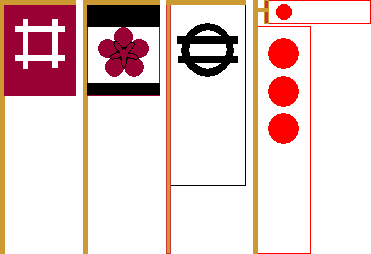- DAIMO FLAGS
- In Japanese usage now obsolete, a generic term for those flags that were in use prior
to the Imperial restoration of 1868/71 a nobobi, hata-sashimono and/or sashimono (see also
hinomaru and mon)

- DANCETTY
- See serrated.
- DANGER FLAG
- See red flag 1).
- DANNEBROG
- Literally Danish-cloth, and the current national flag of Denmark. (see also
splittflag)

National Flag of Denmark (fotw)
- DE FACTO
- (adj) A generally employed Latin term for in practice, and used in vexillology
to indicate flags in actual use as opposed to those as laid down by law or regulation
(see also de jure and the note below).
- DE JURE
- (adj) A generally employed Latin term for in law, and used in vexillology
to indicate a flag as laid down by law or regulation, as opposed to those in actual
use (see also flag law,
de facto,
specification sheet,
and the note below).
Please note that an example of de jure as opposed
to de facto is the proportions of the Belgian national flag which is regulated
at 13:15, but which is most often see in practice with a ratio of 2:3.
- DEBASED
- See reversed 2).
- DECKING
- A term for the custom of foot guards in British and Canadian service of placing
a garland or chaplet of laurel a crown triumphal - at the top of the regimental
colour pike or staff on days of significance in regimental history (see also
colour 2),
colours 2),
crown triumphal,
garland,
pike,
staff 2) and
wreath of immortelles).
- DECOMMISSIONING PENNANT
- See paying off pennant.
- DEFACE
- (v) To add any authorised emblem, badge, shield, charge or device to a flag
(see also
archivexillum,
badge,
charge,
'device',
emblem
shield) and
undefaced.
Please note that in heraldry and vexillology the
term has no pejorative connotation (but see also
desecrate and
disfigure).
- DEMONSTRATION BANNER
- See banner 3).
- DEPTH
- See width 1).
- DESCATE
- (adj) A term used to describe a rounded (or lanceolate) fly into which a V shaped notch
has been cut, and a shape often seen in UK cavalry guidons cloven descate (see also
fly 1),
guidon 2), lanceolate,
pennant and
swallow tail(ed)).
![[descate flag]](../images/v/vxt-d109.gif)
Guidon of the Metropolitan Police Mounted Branch, UK (Herman FMY)
- DESECRATE
- 1) (v) To maliciously damage or mistreat a flag for political or other
motives, or to use a flag in a way that is considered disrespectful or
inappropriate (see also
rules of respect and
Appendix II).
- 2) See disfigure.
- DESCENDING DIAGONAL
- A diagonal stripe that runs from the upper hoist to the lower fly, and is
centred on the corners of the flag a bend. See also
ascending diagona;,
bend in Appendix VI (also
east-west diagonal,
north-south diagonal,
south-north diagonal and
west-east diagonal).
![[descending diagonal flag]](../images/v/vxt-d111.gif)
Flag of Para, Brazil (fotw)
- DESECRATE
- 1) (v) To maliciously damage or mistreat a flag for political or other motives, or to use a flag in a way that is
considered disrespectful or inappropriate (see also rules of respect and
Appendix II).
- 2) See disfigure.
- DESIGNATING (OF HEADQUARTERS) FLAG
- See headquarters flag 2).
- DESK FLAG (or DESK TOP FLAG)
- See table flag.
- DESTINATION FLAG
- The term describing a custom whereby the flag of the country of destination
is flown at the fore by a merchant ship or pleasure vessel as a matter of courtesy
when about to sail (see also fore).
- DEVICE
- 1) Originally a heraldic term for a temporary mark extra to the coat of arms
to distinguish those who entered the lists at tournaments, it now refers specifically
to the motto (see motto).
- 2) A term sometimes inaccurately applied to a charge, badge or emblem (see
also badge,
charge and
emblem).
- DEXTER
- The heraldic term for the right hand side of a flag or shield from the point
of view of the bearer, or the left hand side from the point of view of an observer
(see also sinister).
![[descate flag]](../images/v/vxt-d109.gif)



![[descending diagonal flag]](../images/v/vxt-d111.gif)